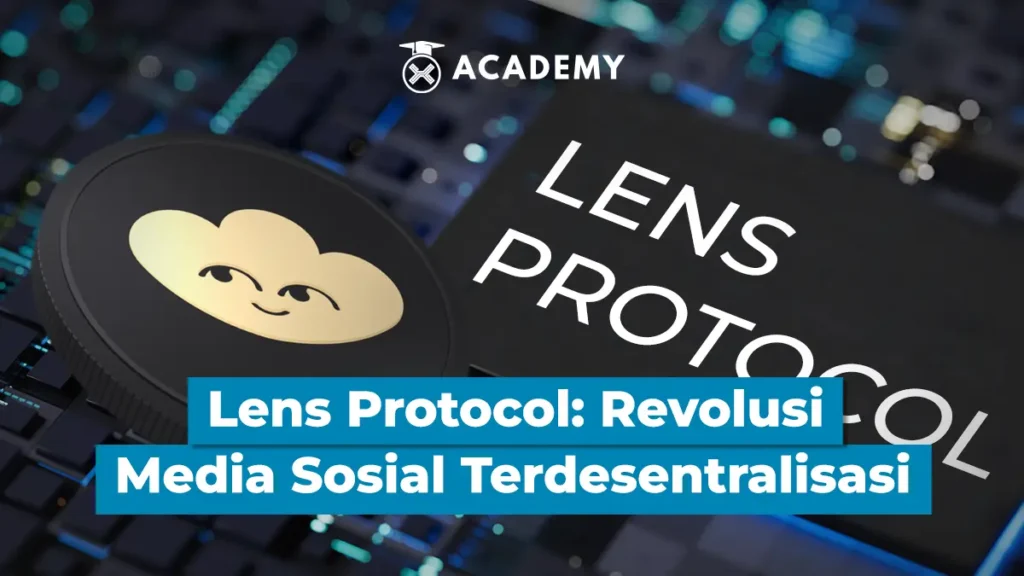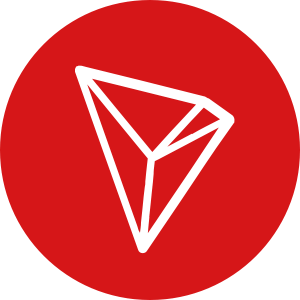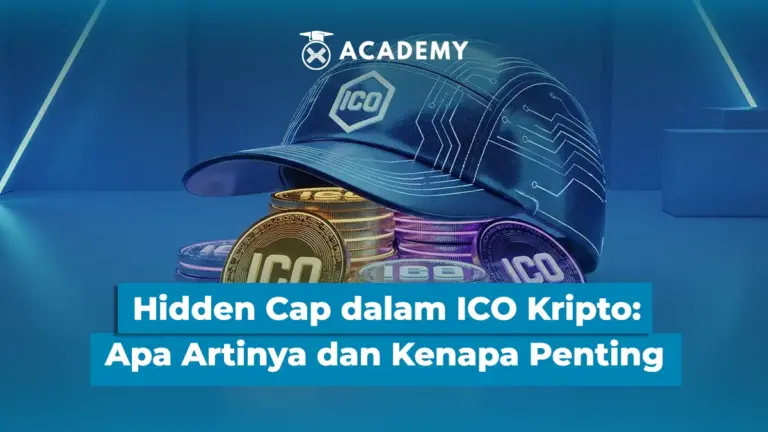In the context of privacy, security, ownership and monetization of data on social media today, there are often obstacles caused by traditional systems that are centralized and still controlled by one particular entity or authority.
To overcome this obstacle comes Lens Protocol, a social media platform with a decentralized concept. This platform allows each user to fully control their own privacy, data ownership, and economic benefits.
Now, to understand more about what Lens Protocol is, from its founder, how it works, its main features, to its advantages over web2 social media, check out the full review below.

What is Lens Protocol?
Lens Protocol is a social graph Web3 protocol built on Polygon blockchain technology. With Lens Protocol, the concept of social media that was previously centralized is transformed into decentralized.
The protocol allows creators to build their own social media platforms and ensures that full control over the content created is in the hands of the user.
Through this technology, Lens Protocol contributes to creating a more open and transparent social media landscape by using non-fungible tokens (NFTs) as assets that represent the identity of user profiles.
Who’s Behind Lens Protocol?
Stani Kulechov, Founder & CEO of Aave, a DeFi (Decentralized Finance), based lending platform, is the main figure behind the development of Lens Protocol.
Kulechov was driven to create Lens Protocol because of his concern for the importance of personal control over each individual’s digital identity.
He also criticized how Web2 social media platforms limit individuals’ ability to manage data, maintain privacy, and monetize their data due to the centralized system implemented.
“Lens Protocol offers social media features such as profile creation, commenting, and reposting content. However, through the NFT, users can own and control all of their own content,” wrote Lens Protocol’s official Twitter account.
Stani Kulechov founded Lens Protocol in Venice, California in 2022. The protocol first launched on the Polygon Mumbai testnet and then moved to the Polygon Mainnet in May 2022.
How Lens Protocol Works
Lens Protocol is a Web3 social graph developed using the Graph Database (GBD). This database utilizes a graph structure to show the relationships between individuals and communities in a social network.
This structure is formed through creating profiles, following other users’ accounts, generating content, and interacting with other content.
Unlike centralized Web2 social media such as Instagram, Facebook, Twitter, TikTok, and YouTube, Lens Protocol integrates the social graph into mart contracts, allowing users to build social media platforms and communities independently.
The social graph owned by Lens Protocol is open, permissionless, and allows any blockchain-based social media platform or DApp to connect to it.
The technology that powers Lens Protocol is built on the eco-friendly Polygon blockchain and uses a proof-of-stake (PoS) mechanism.
The protocol is also compatible with crypto wallets such as MetaMask, Gnosis Safe, and Argent, which opens up opportunities for interoperability across different social media platforms.
Key Features of Lens Protocol
The features present in Lens Protocol are basically inspired by Web2 social media, but it offers a difference by adopting the concept of using NFT.
The NFT is used as a profile that stores all user content, from comments, likes, to reposts, and is connected to the user’s wallet address.
Here are the details of the features in Lens Protocol that you need to know, among others:
- Profile NFTs: Posts and comments are the core of every social media platform. With Lens Protocol, users own all the content they create as it is stored in their Profile NFTs.
- Collect: Collecting posts is a Web3 native feature that serves as a method for creators to earn revenue from their content. Users can collect content from other users and store it as NFTs in their wallet.
- Mirrors: Similar to retweets on Twitter, mirrors refer to any publication that is re-shared. Unlike posts and comments, mirrors are not original content and therefore cannot be collected by other users. On the other hand, mirrors can be used as a new form of advertising as they increase profile visibility
- Follow NFT: When users follow a profile in Lens Protocol, they are awarded Follow NFTs which can be valued by creators and the community.
- Reactions: Similar to Web2 platforms, users can also react to publications with an upvote or downvote. While not monetizable, this metric helps users in discovering content.
Advantages of Lens Protocol Compared to Web2 Social Media
When compared to web2 social media, Lens Protocol has the following advantages, including:
1. Profile Interoperability with Social Media Applications
- Lens Protocol facilitates the use of their profiles across various decentralized social media applications.
- This allows users to carry their identities and followers from one platform to another without losing data or having to rebuild profiles from scratch.
2. Better Privacy and Security
With Lens Protocol, users have full control over their personal data. The decentralized system ensures that data is not stored by one centralized entity, reducing the risk of data breaches and increasing privacy.
3. Direct Monetization by Users
Lens Protocol allows creators to earn revenue directly from their content through features like Collect. Users can monetize their work without the need for intermediaries resulting in a fairer and more transparent revenue stream.
Web3 Implementation on Lens Protocol Social Media Platform
Web3 is attracting attention for its ability to provide profile interoperability with social media applications. With Web3, users have full control over their personal content and can monetize it.
Lens Protocol brings this capability to life through some of their popular social media platforms, including:
1. Lenster
Lenster is a decentralized social media web application developed using the Lens Protocol. Considered the first Web3 social media owned by Lens, Lenster serves as a platform to use Lens Protocol and interact with its social graph.
With an appearance and operation similar to Twitter, Lenster supports various types of NFTs to enrich its user experience.
2. Phaver
Phaver is a dApp platform that combines features from Web2 and Web3 applications. Social media activities in Phaver are similar to Web2, but it comes with incentives for users through ownership in Phaver. Users can issue tokens and share their favorite content, such as blogs, tweets and more.
3. Orb
- Orb uses the Lens Protocol to develop decentralized professional social media applications, designed for professionals who want to connect with the Web3 ecosystem.
- Orb connects individuals, companies, and projects together. Similar to LinkedIn, Orb offers many interesting features, including quizzes that reward NFTs.
How to Get an NFT Profile & Potential Lens Protocol Token Airdrops
For those who want to further explore Lens Protocol, it is important to have an NFT Profile that has a unique name with the suffix “.lens”.
This NFT Profile serves as an identity that includes all activities such as posts, mirrors, comments, and other content created by the user.
However, the free NFT Profile was only distributed at a special event held on August 15, 2022. For new users who are interested in having an NFT Profile, they can purchase it on OpenSea with the following steps:
- Buy NFT Profile on OpenSea. The starting price for an NFT Profile is 200 USDC.
- Users can earn Phaver points to increase their chances of getting an NFT Profile.
Meanwhile, to get the NFT Profile through Phaver, here are the steps, among others:
- Visit https://clique.social/provenance/phaver and complete the tasks given. These tasks include following and contributing to the Phaver and Provenance2026 social media accounts. Both of these accounts will review the Twitter profiles of those signed up and followed to monitor follower counts and impressions. After completing the tasks, submit your entry. Note that this is an application process, so the more active you are, the better your chances of making the list.
- Every week, the Phaver team submits applications for whitelisting to Lens Protocol.
- Check if the wallet address is eligible and can be listed.
- If it is registered then the free NFT Profile can be accessed at https://claim.lens.xyz/.

The Future and Its Development
Although the transition from Web2 to Web3 is still in progress, the benefits offered by blockchain technology in social media have already had a significant impact. Citing data from
wearesocial.com, in the Digital 2024 Global Overview Report published in partnership between We Are Social and Meltwater, there are currently 5,040,000,000 active social media users globally as of early 2024.
Imagine if these billions of social media users adopted blockchain technology through Lens Protocol.
Lens Protocol’s unique features such as interoperability, privacy, security, and the ability to earn immediate revenue can deliver experiences not available on Web2.
Lens Protocol accelerates this revolution with similar projects in the social media space, empowering users to control how their platforms are built, monetized, and profoundly impacting the communication paradigm.
The development of Lens Protocol continues to be rapid, as reported by Messari in the “User Behaviour and Engagement on Lens” report as of April 2023.
Lens revenue reached US$5,540,000, with 93% coming from Profile NFTs and the rest from subscription fees, collections, and referral fees.
Revenue from creators has also increased significantly in the last six months, showing great potential for future growth.
Lens Protocol has a great opportunity to continue growing by attracting more creators and social media users, and building an ecosystem that benefits all users.
With the birth of new features, focused incentive campaigns, smart marketing strategies, and an increased focus on creators, Lens Protocol can strengthen user loyalty and build a more diverse and successful ecosystem in the future.
Conclusion: Why Lens Protocol is the Future of Social Media
To conclude, in essence, Lens Protocol promises a bright future for social media.
In this regard, Lens Protocol brings innovation by giving users full control over their privacy, data ownership, and the ability to monetize their own content through NFT technology.
On the other hand, the integration of NFT technology in Lens Protocol empowers users by allowing them to own and control their content in the form of NFT Profiles, which can also be sold or exchanged.
Furthermore, with a focus on decentralization, Lens Protocol has great potential to transform the traditional paradigm of centralized social media into a more open, transparent, and highly competitive ecosystem.
As for the disclaimer, it is important to understand that the above information is presented as a summary based on the current understanding of Lens Protocol and is not intended as an investment recommendation or financial advice.
Let’s Invest in Crypto on INDODAX
Now, you understand what Lens Protocol is, from its founder, how it works, its main features, to its advantages over web2 social media.
Furthermore, if you are interested in making crypto investments easily, safely, and profitably, including buying bitcoin, buying ethereum, or other crypto assets, then you can buy them through INDODAX Market.
On the other hand, to make it easier to trade crypto safely, you can also download the best crypto application from INDODAX on the Google Play Store or via the App Store right now!
Keep in mind, as the best and most popular crypto asset trading platform in Indonesia supported by 6,000,000 members, INDODAX provides various types of crypto assets, ranging from Bitcoin, Ethereum, to Dogecoin.
INDODAX, which is a pioneer in buying and selling crypto assets in the country, is also committed to providing easy access to the crypto asset market for investors.
As a disclaimer, it should be underlined that investing in crypto assets also has its own risks, as with other types of investments.
The risk is the fluctuating value of crypto assets and the high level of volatility in crypto assets so it is important to do independent research before investing in crypto assets.
So, what are you waiting for? Let’s start investing in crypto assets only with INDODAX!
FAQ
1. What is Lens Protocol?
Answer: Lens Protocol is a Polygon blockchain-based decentralized social media platform that allows users to have full control over their privacy, data ownership, and content monetization through the use of non-fungible tokens (NFTs).
2. Who are the founders of Lens Protocol?
Answer: Lens Protocol was founded by Stani Kulechov, founder and CEO of Aave, a decentralized finance (DeFi) lending protocol platform. Kulechov created Lens Protocol to give control over digital identity to every individual.
3. How does Lens Protocol work?
Answer: Lens Protocol uses a Graph Database (GBD) to build a social graph structure that shows the relationships between individuals and communities. This social graph is integrated into smart contracts, allowing users to build social media platforms and communities independently.
4. What are the main features of Lens Protocol?
Answer: The main features of Lens Protocol include Profile NFTs (content ownership by users), Collect (content monetization), Mirror (content re-sharing), Follow NFTs (added value for followers), and Reactions (upvote and downvote).
5. How do I get an NFT Profile in Lens Protocol?
Answer: NFT Profiles can be purchased through OpenSea or earned by earning points through Phaver. Users must complete tasks in Phaver and follow the application process to get a free NFT Profile.





 Polkadot 9.23%
Polkadot 9.23%
 BNB 0.47%
BNB 0.47%
 Solana 4.89%
Solana 4.89%
 Ethereum 2.37%
Ethereum 2.37%
 Cardano 1.22%
Cardano 1.22%
 Polygon Ecosystem Token 2.16%
Polygon Ecosystem Token 2.16%
 Tron 2.83%
Tron 2.83%
 Market
Market


